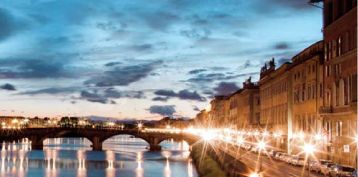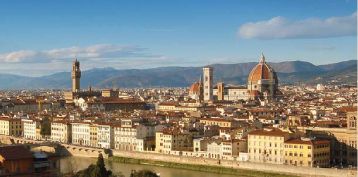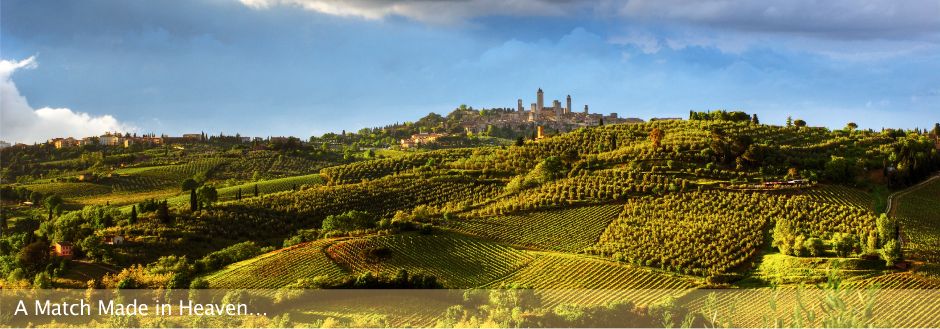| Wedding planner |
Settings | Ceremonies | Locations | Services | Wedding guests |
Lodgings | Reviews | Contacts |
Locations
Our locations are a selection of medieval hilltop towns in Tuscany Italy adorned with incredible art treasures and surrounded by spectacular natural landscapes. Our philosophy is to avoid big chaotic towns in order to soak up the magic atmosphere of local villages and charming small towns.
The natural setting of your wedding will be the gorgeous Tuscan countryside, where you can enjoy the peace and the tranquillity of this much sought after region.
Firenze
 Florence is a unique town which developed in an admirable location on the banks of the River Arno in a large valley surrounded by the gorgeous scenery of the Tuscan countryside, with gentle hills on three sides to form a natural amphitheatre. Florence is considered one of the most prestigious towns in Italy, especially for its art and architecture. It was the cradle of the Italian language and art - Renaissance Art in particular, and the birthplace of famous artists. Due to its artistic and cultural importance, it was declared a UNESCO World Heritage Site in 1982, and it is acknowledged as one of the most beautiful towns in the world thanks to its fine historical monuments such as the Cathedral, the church of Santa Croce, the Uffizi Gallery, Ponte Vecchio, Piazza della Signoria, and Palazzo Pitti.
Florence is a unique town which developed in an admirable location on the banks of the River Arno in a large valley surrounded by the gorgeous scenery of the Tuscan countryside, with gentle hills on three sides to form a natural amphitheatre. Florence is considered one of the most prestigious towns in Italy, especially for its art and architecture. It was the cradle of the Italian language and art - Renaissance Art in particular, and the birthplace of famous artists. Due to its artistic and cultural importance, it was declared a UNESCO World Heritage Site in 1982, and it is acknowledged as one of the most beautiful towns in the world thanks to its fine historical monuments such as the Cathedral, the church of Santa Croce, the Uffizi Gallery, Ponte Vecchio, Piazza della Signoria, and Palazzo Pitti.
HISTORY
It is the Renaissance time which has made Florence known all over the word. Very few reminders of Florence early origin are visible today. During the Middle Ages, Florence flourished as a medieval commune thanks to its trading and banking which made it politically, economically and culturally important in Europe. In the 15th century, Florence was among the largest European cities. Florence history at that time was strictly linked to the history of the Medicis . Lorenzo de' Medici, being a great patron of the arts, commissioned works by many important artists such as Michelangelo, Leonardo and Botticelli. After the Medici dynasty finished, Florence was temporarily included in the territories of the Austrian crown. Tuscany became a province of the United Kingdom of Italy in 1861 and Florence was Italy's capital in 1865. Florence steadily grew during the 19th and 20th century. It experienced a one-year German occupation during World War II, and it was freed by the allied soldiers.
MAIN FEATURES
Florence is the capital town of Tuscany. Due to Florence's artistic and architectural heritage, it has been ranked by Forbes as one of the most beautiful cities in the world. Florence is also an important city in Italian fashion, being ranked within the top fifty fashion capitals of the world. It is also a major national economic centre, being a tourist and industrial hub. Besides visiting the main historical monuments of Florence, the most charming experience is exploring the narrow streets of the centre, with its many handicraft workshops, restaurants and osterias where you can try the typical dishes of the old Florentine cooking tradition, whilst enjoying the magic atmosphere of secret artistic treasures.
MAIN SIGHTS
 Under the Medici leadership Florence became a concentrate of art and architecture, with its many historical buildings, monuments, and museums with precious works (such as the Uffizi Gallery, Accademia , the Bargello and Palazzo Pitti. The Cathedral of Santa Maria del Fiore, consecrated in 1436 at the end of the works of the Brunelleschi's Dome, is covered with the famous cycle of frescoes (3600sqm) painted by Giorgio Vasari and Federico Zuccari between 1572-1579. Piazza della Signoria is Florence's main square and a unique outdoor sculpture gallery. The square is the heart of the town's social life and hosts Palazzo Vecchio, the seat of Florentine politics.
Under the Medici leadership Florence became a concentrate of art and architecture, with its many historical buildings, monuments, and museums with precious works (such as the Uffizi Gallery, Accademia , the Bargello and Palazzo Pitti. The Cathedral of Santa Maria del Fiore, consecrated in 1436 at the end of the works of the Brunelleschi's Dome, is covered with the famous cycle of frescoes (3600sqm) painted by Giorgio Vasari and Federico Zuccari between 1572-1579. Piazza della Signoria is Florence's main square and a unique outdoor sculpture gallery. The square is the heart of the town's social life and hosts Palazzo Vecchio, the seat of Florentine politics.
The Ponte Vecchio is one of the symbols of Florence and it crosses the Arno River in its narrowest point. The first building on the bridge dates back to the Romans. It was the only bridge in the city to escape being blown up during World War II. Panoramic views of the whole towns can be enjoyed from the surrounding hills, and especially from Forte Belvedere, Piazzale Michelangelo and from the Tuscan hilltop town of Fiesole, which offers spectacular views over the Arno valley.
| Home page|Wedding planner|Settings|Ceremonies|Locations|Services|Wedding guests|Lodgings|Reviews|Contacts |

